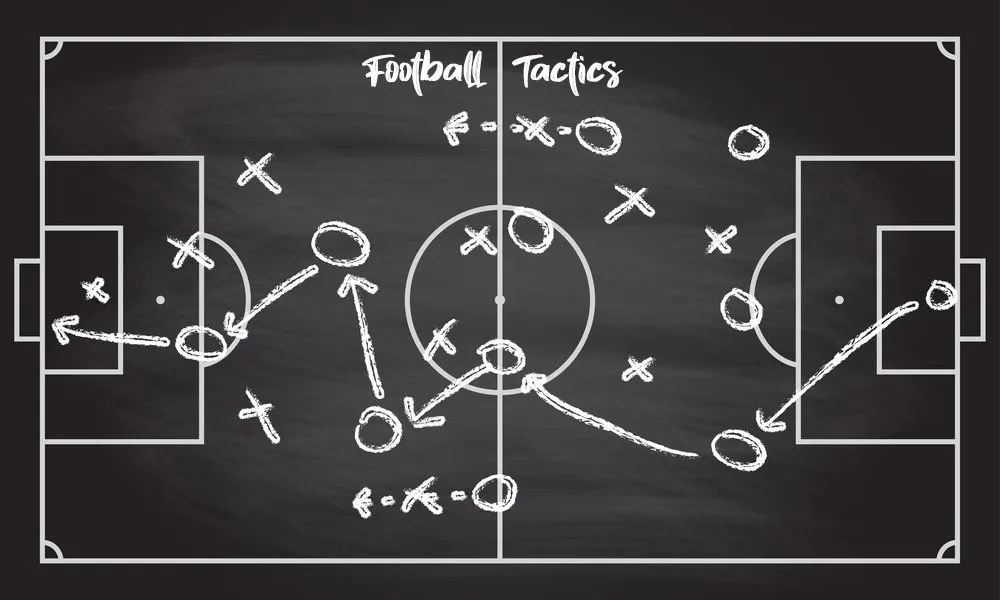Football tactics have undergone a remarkable transformation since the sport’s early days, evolving from rigid formations to fluid systems that adapt mid-game. This 1,800-word tactical masterclass explores how strategic innovations have shaped modern football and what the future holds for the beautiful game.
The Birth of Organized Formations (1860s-1920s)
1-1-8: Football’s Primitive Beginnings
-
Used by early English teams
-
Single defender, one midfielder, eight attackers
-
Chaos reigned until offside rule changes
The Pyramid (2-3-5) Revolution
-
First structured formation (1880s)
-
Two fullbacks, three halfbacks, five forwards
-
Dominated for 40+ years
-
“The Pyramid made football a thinking man’s game” – Football Historian Jonathan Wilson
Defensive Reinventions (1930s-1950s)
WM Formation (3-2-2-3)
-
Created by Herbert Chapman (Arsenal)
-
Response to 1925 offside rule change
-
First to balance defense and attack
Key Innovations:
| Era | Formation | Pioneer | Impact |
|---|---|---|---|
| 1930s | WM | Chapman | Structured defense |
| 1950s | 4-2-4 | Hungary | Total Football precursor |
Total Football Era (1960s-1980s)
Ajax and Holland’s 4-3-3 Mastery
-
Positional interchangeability
-
Johan Cruyff as the “first false nine”
-
Pressing introduced as a weapon
Rinus Michels’ Philosophy:
“Every player should be comfortable in every position”
Italian Catenaccio (1-3-3-3)
-
Helenio Herrera’s defensive art
-
Libero position created
-
Counter-attacking perfected
Modern Tactical Revolution (1990s-Present)
Formation Timeline:
| Decade | Dominant Formation | Key Team |
|---|---|---|
| 1990s | 4-4-2 | Manchester United |
| 2000s | 4-2-3-1 | Mourinho’s Chelsea |
| 2010s | 4-3-3 | Guardiola’s Barcelona |
| 2020s | 3-2-5 | Arteta’s Arsenal |
Pep Guardiola’s Innovations
-
Inverted fullbacks
-
Positional play principles
-
False nine resurrection
Current Tactical Trends (2024 Analysis)
Hybrid Systems Dominate
-
Arsenal’s 3-2-5 in possession
-
Man City’s 2-3-5 build-up
-
Liverpool’s 4-3-3 defensive shape
Key Statistics:
-
78% of Premier League teams now use fluid formations
-
Fullbacks complete 28% more passes than 10 years ago
-
Center backs now make 4.3 progressive carries per game (up from 1.2 in 2014)
Positional Evolution: New Roles Emerge
Modern Player Archetypes:
-
The Ball-Playing Keeper (Ederson, Alisson)
-
Inverted Fullback (Zinchenko, Cancelo)
-
Box-to-Box Playmaker (Bellingham, Rice)
-
False Winger (Foden, Griezmann)
“Today’s fullbacks must play like midfielders and defend like center backs” – Trent Alexander-Arnold
Data-Driven Tactics
How Analytics Changed the Game:
-
Expected Goals (xG) informs shooting positions
-
Pressing triggers calculated by tracking data
-
Set-piece routines algorithmically optimized
Brighton’s Moneyball Approach:
-
Signed Caicedo for £4m using data models
-
Developed Mac Allister through targeted training
The Future of Football Tactics (2025-2030)
Predicted Developments:
-
AI-Assisted Real-Time Adjustments
-
Positionless Football (Total fluidity)
-
Biometric-Based Substitutions
-
Holographic Training Simulations
Challenges Ahead:
-
Maintaining football’s spontaneity
-
Balancing technology with tradition
-
Preventing tactical homogenization
How Amateur Coaches Can Adapt
5 Practical Tips:
-
Study multiple formations
-
Focus on principles over rigid systems
-
Develop versatile players
-
Use simple video analysis
-
Encourage creative problem-solving
Conclusion: The Never-Ending Chess Match
Football tactics continue evolving at breakneck speed, blending art and science in new ways. As Johan Cruyff famously said, “Football is simple, but playing simple football is the hardest thing there is.” The teams that master this balance between structure and creativity will define football’s next era.
Want to master modern tactics?
Learn more at SoccerNewsz.com


No comment